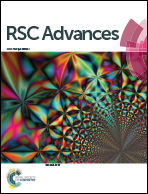Effect of different donor groups in bis(6-methoxylpyridin-2-yl) substituted co-sensitizer on the performance of N719 sensitized solar cells
Abstract
Three bis(6-methoxylpyridin-2-yl) substituted pyridine-anchor co-sensitizers with different donor groups are synthesized by 1,2-diaminobenzene (named L4), 1,2-diaminocyclohexane (named L5) and 1,4-butanediamine (named L6) with the aim to obtain rigid, semi-rigid and flexible co-sensitizer molecules, respectively. Their adaptability in N719 sensitized solar cells as co-sensitizers and the effects of their molecular rigidity, conjugation and co-planarity on the performance of DSSCs are studied. The results show that these three co-sensitizers are suitable to use in N719 sensitized solar cells. However, due to the different donor groups in the molecular structure, the co-sensitization performance of the rigid co-sensitizer with a large conjugate system is better than that of semi-rigid and flexible co-sensitizers. A short circuit current density of 13.27 mA cm−2, an open circuit voltage of 0.73 V and a fill factor of 0.63 corresponding to an overall conversion efficiency of 6.16% under AM 1.5G solar irradiation were achieved when rigid L4 was used as the co-sensitizer, which is 30% higher than that for DSSCs only sensitized by N719 (5.37%) under the same conditions. Mechanistic investigations are carried out by various spectral and electrochemical characterizations.


 Please wait while we load your content...
Please wait while we load your content...